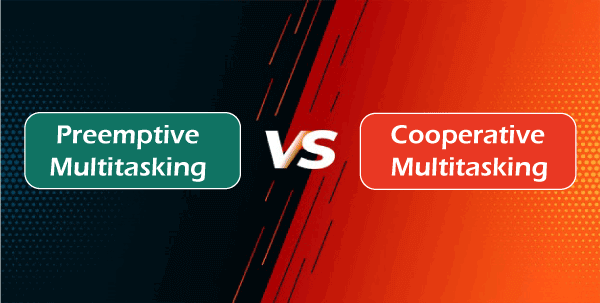Difference between Preemptive and Cooperative MultitaskingMultitasking is the method of running several programs or processes at the same time. Most modern OS support multitasking for maximum processor utilization. There are mainly two types of multitasking which are Preemptive and Cooperative multitasking. In this article, you will learn about the difference between Preemptive and Cooperative multitasking in the operating system. But before discussing the differences, you must know about Preemptive and Cooperative multitasking in the operating system. What is Preemptive Multitasking?The operating system may start a context switching from one process that is currently running to another during preemptive multitasking. In other words, the OS enables you to stop the execution of the existing process and reallocate the processor to another. The operating system (OS) utilizes a set of criteria to determine how long a process should run before granting access to the OS to another process. Some OSs assigns priorities to the processes. In those circumstances, the process with the higher priority is executed first before the process with the lower priority. After that, the higher priority processes get controlled as they are initiated. Furthermore, those processes may be given extended time slices to complete. Example: It is utilized by UNIX, Windows 95, and Windows NT. What is Cooperative Multitasking?Cooperative multitasking is also referred to as preemptive multitasking. The operating system never starts context switching from one executing process to another during cooperative multitasking. A context switch occurs when processes voluntarily yield control regularly or when they are inactive or logically halted to enable many apps to run concurrently. Additionally, all processes cooperate in cooperative multitasking for the scheduling method to work. In cooperative multitasking, the OS process scheduler is referred to as the cooperative scheduler. Applications may be implemented more quickly, but it is rarely utilized in large and complex systems. Although, programming languages like Python and JavaScript are utilized with a single-threaded event loop on their execution. Example: It is utilized by Mac OS version 8.0-9.2.2 and Windows 3.x. Key differences between Preemptive and Cooperative Multitasking in Operating System
Here, you will learn about the various key differences between Preemptive and Cooperative multitasking in operating systems. Some main differences between Preemptive and Cooperative multitasking in operating systems are as follows:
Head-to-head comparison between the Preemptive and Cooperative Multitasking in Operating SystemThe operating system has various head-to-head comparisons between Preemptive and Cooperative Multitasking in the operating systems. Some comparisons of Preemptive and Cooperative Multitasking in operating systems are as follows:
ConclusionIn summary, both preemptive and cooperative multitasking are two types of multitasking. The primary distinction between these OS is that the OS may initiate a context switch from a running process to another in preemptive multitasking. In contrast, the OS doesn't start a context switch from an existing process to another in cooperative multitasking. |
 For Videos Join Our Youtube Channel: Join Now
For Videos Join Our Youtube Channel: Join Now
Feedback
- Send your Feedback to [email protected]
Help Others, Please Share









